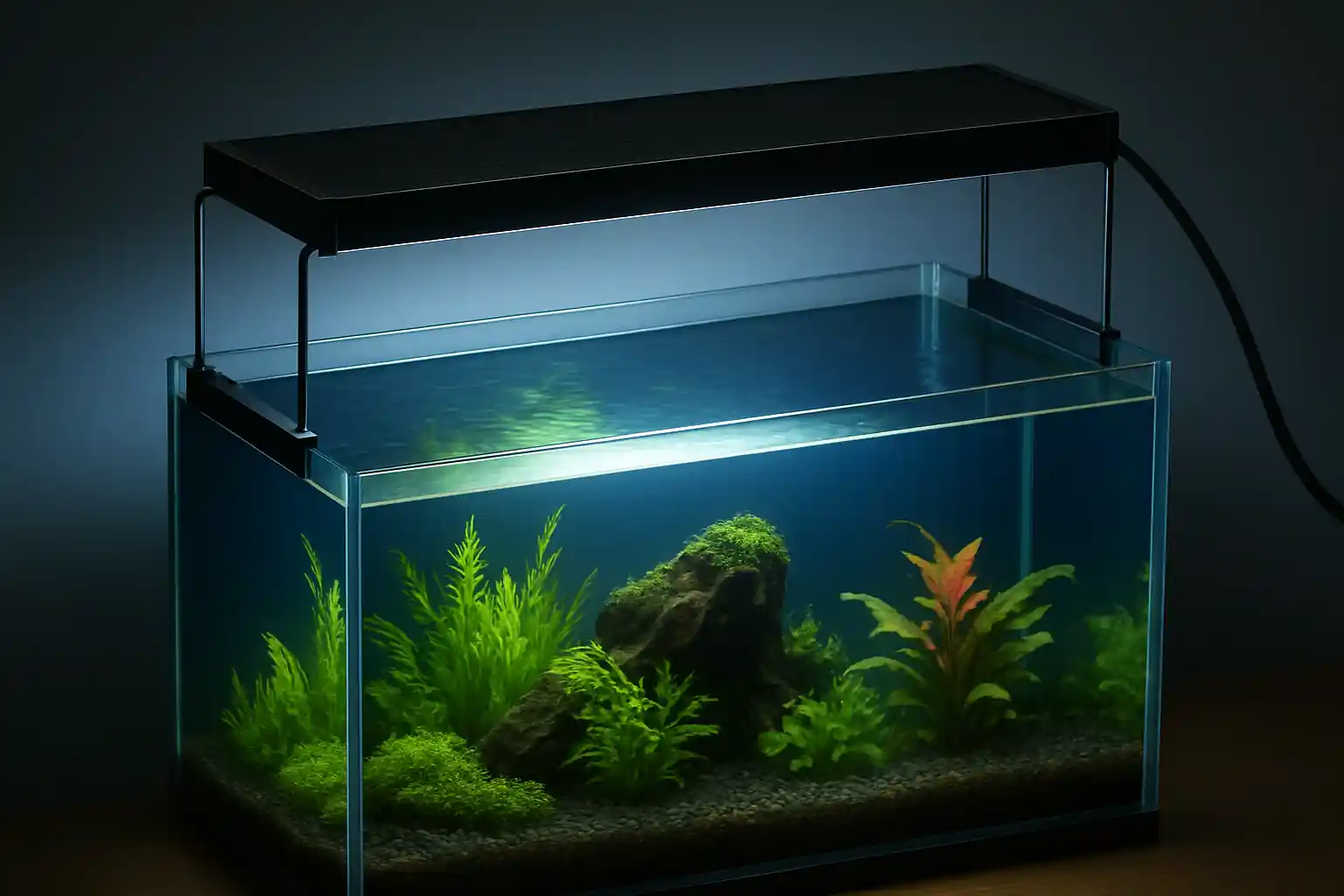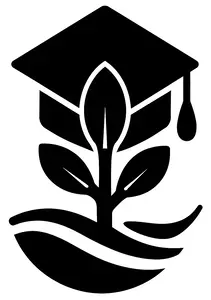
Best Aquarium Lighting Guide: Brighten Your Aquarium Like a Pro
Introduction
Aquarium lighting is more than just a design choice — it’s essential to a healthy, balanced tank. The right aquarium lighting supports plant growth, reduces stress for your fish, and shapes the visual atmosphere of your aquascape. In this guide, you’ll learn how to choose the best aquarium lighting setup, from spectrum and intensity to PAR values, timer settings, and algae prevention.
What you’ll learn in this lesson
- The science behind aquarium lighting and plant growth
- How to choose the best light for your aquarium size and type
- Understanding PAR, Kelvin, CRI, and light spectrum
- LED vs fluorescent vs metal halide options
- Biotope-specific lighting strategies
- Seasonal and automated lighting controls
- Sustainable lighting practices
- Lighting mistakes that cause algae or stress fish
- Real-world aquascaping examples and lighting setups
- Visual tricks to highlight aquascaping features
Advanced Tools for Measuring and Adjusting Light
- PAR Meters: e.g., Apogee MQ-510 or Seneye Reef
- Lux Meters: Use for quick comparisons across zones
- Smart Apps: Chihiros, ONF Link, Fluval, Twinstar
Pro Tip: Take PAR readings at substrate and mid-water levels for better calibration.
The Role of Light in Photosynthesis Efficiency (Quantum Yield)
Photosynthesis in aquatic plants is driven by light—but not all light is equally efficient. Quantum yield refers to how effectively a plant converts light into chemical energy.
- Red and blue wavelengths (around 450 nm and 660 nm) have the highest quantum efficiency
- Green light is often reflected but still contributes to depth penetration
- Modern LEDs optimized for photosynthesis often show peaks in red and blue ranges
Understanding this helps aquascapers select lights that maximize plant growth rather than just visual appeal.
Combining Lighting With CO₂ and Fertilization
- High Light Tanks: Require pressurized CO₂ and regular macro/micro dosing
- Medium Light Tanks: Can use liquid carbon supplements
- Low Light Tanks: Root tabs are often sufficient
Balance is key: Too much light without nutrients = algae disaster.
Lighting Effects on Water Chemistry
Although lighting doesn’t directly change water chemistry, it can trigger indirect effects:
- Photosynthesis raises pH temporarily by consuming CO₂
- Oxygenation increases during photoperiods due to plant respiration
- UV sterilizers, though technically not “lighting”, can influence nutrient breakdown and pathogen control
Balanced lighting schedules help maintain a stable environment.
Best Practices for Planted Tank Lighting Maintenance
- Clean fixtures weekly
- Check timers for accuracy
- Replace fluorescent bulbs annually
- Log PAR readings over time
Avoid neglecting splash guards—they can get foggy and reduce light output.
Emergency Lighting Solutions for Power Outages
Power failures can endanger sensitive planted tanks. Consider:
- Uninterruptible Power Supplies (UPS) to run low-wattage LED systems temporarily
- Portable battery lights or clip-ons for short-term use
- Solar backup systems for off-grid or eco-friendly aquariums
Preparation prevents plant die-off and fish stress in outages.
Real-World Aquascaping Examples and Lighting Choices
Case Study 1: 60L Iwagumi Tank
- Light: Chihiros WRGB II Slim
- Photoperiod: 6.5 hours/day
- PAR: ~90 at substrate
- CO₂: Pressurized
Case Study 2: 120L Dutch Aquascape
- Light: Twinstar 900SA
- Photoperiod: 8 hours/day with ramp-up
- PAR: 150–180
- CO₂: Inline diffuser
Case Study 3: 200L Jungle Tank
- Light: Fluval Plant 3.0
- Photoperiod: 7 hours/day
- PAR: ~40
- CO₂: None
Each setup shows how lighting should match tank style and plant demand.
Retrofitting Old Tanks with Modern Lighting
Upgrading older aquariums to LEDs is highly beneficial:
- T5/T8 to LED bars: Use mounting brackets or adapters
- Splash guard retrofits: Install clear acrylic shields to protect new lighting
- Open-top vs. canopy: LEDs allow more flexible designs and airflow
Make sure to check power compatibility and heat output.
Integrating Light With Aquascape Composition Principles
- Golden Ratio: Use light to highlight focal points
- Negative Space: Keep shadows in low-plant areas
- Color Contrast: Adjust spectrum to bring out reds and greens
Lighting and Its Psychological Impact on Viewers
- Cool Light (7000K–8000K): Energizing, sharp
- Warm Light (4000K–5000K): Natural, calming
- Dynamic Ramping: Mimics natural day cycles, improves mood
Aquariums with good lighting reduce anxiety and boost concentration.
Managing Natural Light: Windows, Sunlight & Algae
Sunlight can be both friend and foe in aquascaping:
- Avoid direct sunlight: It causes heat and algae issues
- Use blinds or reflective film: To reduce exposure during peak sun hours
- Ambient daylight: Can be complementary if balanced with artificial light
Position your tank away from south-facing windows when possible.
Advanced Light Scheduling: Circadian and Environmental Simulation
- Dawn: 30–60 min ramp-up
- Peak: 4–6 hrs of full intensity
- Dusk: 1 hr dim-down
- Moonlight: Soft blue optional for viewing, not necessary for fish
Use ONF or Chihiros apps to build custom lighting routines.
How to Interpret Spectral Graphs from Manufacturers
Many lighting companies publish spectral output graphs, but interpreting them correctly is key:
- Look for distinct peaks around 450 nm (blue) and 660 nm (red)
- A broad continuous curve indicates balanced white light
- High Color Rendering Index (CRI) suggests a natural appearance
Compare brands like ADA Solar RGB and Twinstar to see the difference in spectrum.
Lighting for Non-Standard Aquarium Shapes
Unique tanks need customized lighting approaches:
- Cube tanks: Central LED pendant lights work well
- Long shallow tanks: Use wide-angle LEDs or multiple smaller units
- Paludariums: Combine spotlights for land plants and diffuse light for water
Use reflectors or diffusers to ensure even coverage and avoid shadows.
Mythbusting: Common Lighting Misconceptions
- “More light = better growth” — Only if nutrients and CO₂ match
- “Red light is harmful” — No evidence for typical intensities
- “All LEDs are equal” — Spectrum and build quality matter
- “Tanks need 12 hrs light” — 6–8 hrs is optimal for most
Lighting and Aquarium Photography
- Light should come from above or the front
- Avoid glare with polarized lenses
- Dim room lights during shooting
- Use macro mode to highlight plants/fish
Tip: Take photos 1–2 hrs after lights turn on for best color.
Understanding Lighting Spread and Angle
- Narrow Beams (<60°): Create spotlight effects and are ideal for deep tanks or feature highlighting
- Wide Beams (90°–120°): Better for shallow tanks and broad, even plant coverage
- Lenses and Reflectors: Improve efficiency and direct light exactly where it’s needed
Proper spread ensures all plant zones receive adequate lighting without overexposing surface areas.
LED Aquarium Lighting: The Modern Standard
- Energy Efficient: Use up to 70% less energy than older bulbs
- Longevity: 30,000–50,000 operating hours
- Full-Spectrum Tuning: Adjust Kelvin, RGB, intensity
- Smart Features: Bluetooth/Wi-Fi control, presets, and ramping functions
Top-tier LEDs like ONF Flat One+ and Chihiros WRGB II offer professional-grade results.
Fluorescent and Metal Halide Lighting: Still Relevant?
While LEDs dominate, older tech still sees niche use:
- T5HO (High Output): Good spectrum and intensity, especially for wide tanks
- Metal Halides: High PAR for deep tanks but produce a lot of heat and consume more power
- T8 Bulbs: Largely outdated — low efficiency and poor spectrum control
LED retrofits are almost always a worthwhile upgrade.
Choosing the Right Aquarium Light for Your Tank Size
| Tank Height | Recommended Light Type |
|---|---|
| Under 30 cm | Low to medium LED, 6,500K standard |
| 30–60 cm | Mid-range LED or T5HO |
| Over 60 cm | High-output LED or suspended light |
Always measure PAR at substrate level when in doubt.
Matching Light to Aquascape Style
- Iwagumi: Use directional lighting to enhance rock texture
- Dutch: Broad, uniform lighting for plant walls
- Nature Style: Simulate sunlight with gradual ramping
- Diorama: Employ backlight or low-angle light for cinematic depth
Aquarium Lighting and Plant Types
| Plant Type | Light Requirement |
|---|---|
| Anubias, Moss | Low light |
| Crypts, Vals | Medium light |
| Rotala, HC | High light + CO₂ |
Choose lighting based on the most demanding species in your tank.
How Lighting Interacts with Substrate and Backgrounds
- White Substrate: Reflects light, brightens the tank
- Dark Soil: Creates contrast, may absorb more light
- Black Background: Enhances plant and fish colors, improves perceived depth
- Frosted Backgrounds: Diffuse light and add atmosphere
Background and base color can drastically change how lighting is perceived.
Biotope-Specific Lighting Strategies
Tailoring lighting to match natural habitats:
- Amazon (South America): Warm white (4,500K–5,500K), tannin-tinted
- Asian Streams: Crisp daylight white (6,500K)
- African Lakes/Rivers: Variable — mimic shallow shoreline or deeper shaded zones
Floating plants and driftwood help simulate natural filtered lighting.
Seasonal and Circadian Adjustments
- Summer Setup: 8–10 hour photoperiod, higher PAR
- Winter Setup: 6–7 hours, reduce intensity
- Syncing with Room Lighting: Use ambient light sensors if available
Avoid sudden lighting shifts — transitions should be gradual.
Lighting Effects on Fish Behavior
- Color Enhancement: Bright, full-spectrum light boosts natural fish colors
- Stress Reduction: Gradual transitions prevent shock
- Breeding Behavior: Some species respond to seasonal lighting cues
- Rest Periods: Darkness is essential for recovery and healthy circadian rhythms
Watch for signs of distress like hiding, gasping, or faded colors.
Preventing Algae Through Smart Lighting
- Duration: Limit to 6–8 hrs for most tanks
- Spectrum: Avoid excessive green-yellow peaks
- Balance: Pair lighting with CO₂ and fertilization
- Sunlight: Never place tanks in direct sun
Track nutrient levels and photoperiod changes if algae appear.
Using Lighting to Highlight Aquascaping Layers
- Foreground Plants: Low-angle, diffused lighting
- Midground: Balanced intensity for bushy growth
- Background Plants: Slightly brighter light to create a layered, receding effect
- Focal Points: Use subtle spotlighting or beam shaping
This helps create a sense of depth and professional layout.
DIY Lighting Tips & Budget Options
- LED Strip Lights: 6,500K strips with waterproof coating
- Reflective Tape: Increases light efficiency
- Timers: Basic mechanical or digital outlet timers
- Heat Management: Use aluminum channels as passive heatsinks
DIY setups are great for nano tanks or shallow displays.
Automation and Smart Lighting Controls
Modern lighting offers a host of automation options:
- Bluetooth or Wi-Fi control: Set schedules from your phone
- Presets: For daylight simulation, storm modes, moonlight
- Integration: Some systems work with Alexa or Google Assistant
- Data Tracking: Monitor PAR, usage, and photoperiod history
This is especially useful for aquascapers managing multiple tanks.
Comparing Budget vs Premium Lighting Brands
| Brand | Price Range | Features | Best For |
|---|---|---|---|
| NICREW | $30–60 | Timer control, basic spectrum | Beginners, small tanks |
| Fluval Plant 3.0 | $120–200 | App-controlled, full spectrum | Intermediate planted tanks |
| Chihiros WRGB II | $150–250 | High PAR, RGB tuning, app-based | Mid to advanced aquascapers |
| ONF Flat One+ | $250+ | High CRI, ultra-flat design, presets | Pro-level aquascaping |
| ADA Solar RGB | $300+ | Premium color rendering, artistic look | ADA-style tanks |
Choose based on tank size, plant type, and desired control.
Sustainability and Energy Efficiency in Aquarium Lighting
- LED Efficiency: Look for high lumens per watt
- Smart Scheduling: Avoid unnecessary hours
- Replaceable Parts: Brands with modular design reduce waste
- Low-Impact Manufacturing: Some companies use recyclable materials or solar-powered production
A greener tank saves money and benefits the environment.
Common Mistakes to Avoid
- Using excessive light duration
- Choosing the wrong spectrum
- Ignoring CO₂ or fertilization needs
- Buying too weak or too strong lights
- Forgetting to clean light lenses or splash covers
Saltwater vs Freshwater Aquarium Lighting
Saltwater aquariums have different lighting demands:
| Aspect | Freshwater | Saltwater (Reef) |
|---|---|---|
| Spectrum | 6,000–7,500K full-spectrum | 10,000–20,000K with high blue intensity |
| Focus | Plant growth & color tones | Coral fluorescence & photosynthesis |
| Equipment | Standard LED or T5 | High PAR reef LED or metal halide |
| Photoperiod | 6–8 hrs | Often 8–12 hrs (corals require longer) |
Freshwater tanks emphasize aesthetic and plant health; saltwater requires high PAR for coral vitality.
Quick Takeaways
- 6,500K spectrum is ideal for planted tanks
- Use timers or apps for consistency
- Match light intensity to plant and tank type
- Don’t overexpose tanks without CO₂
- Lighting can enhance depth, color, and emotional impact
Conclusion
Aquarium lighting is a tool of science and art. With the right understanding and equipment, you can turn any tank into a thriving, vivid world. Balance light with plants, fish, and if needed the aquascape style — and your underwater scene will truly shine.
💬 Join the Conversation
Tag us on Instagram @AquariumLesson — we’d love to see your lighting setups!
FAQ
What is the best light for planted aquariums?
Full-spectrum LED with proper PAR values for your tank size and plants.
Can I leave the aquarium light on overnight?
No. Fish need darkness. Algae grows in continuous light.
What PAR value is ideal for carpet plants?
Usually 80–120 µmol/m²s at the substrate level.
Are RGB lights good for aquascaping?
Yes, if adjustable and full-spectrum capable.
Is warm or cool lighting better?
Depends on biotope and mood — warm = natural, cool = vibrant.
Should I use a timer?
Absolutely. Automated lighting prevents algae and stress.
Can light affect fish color?
Yes. Bright, full-spectrum lighting enhances natural pigmentation.
Do low-tech tanks need expensive lights?
No. Budget LEDs work if PAR and spectrum are appropriate.
References
- Tropica Aquarium Plants → Expert plant care and lighting resources
- Aquasabi Blog → Equipment guides and tests
- George Farmer YouTube → Lighting tutorials and demos
- ADA – Aqua Design Amano → Lighting design and layout principles
- Aquarium Filter Guide → Water flow and lighting synergy
Inspire someone – share this post


